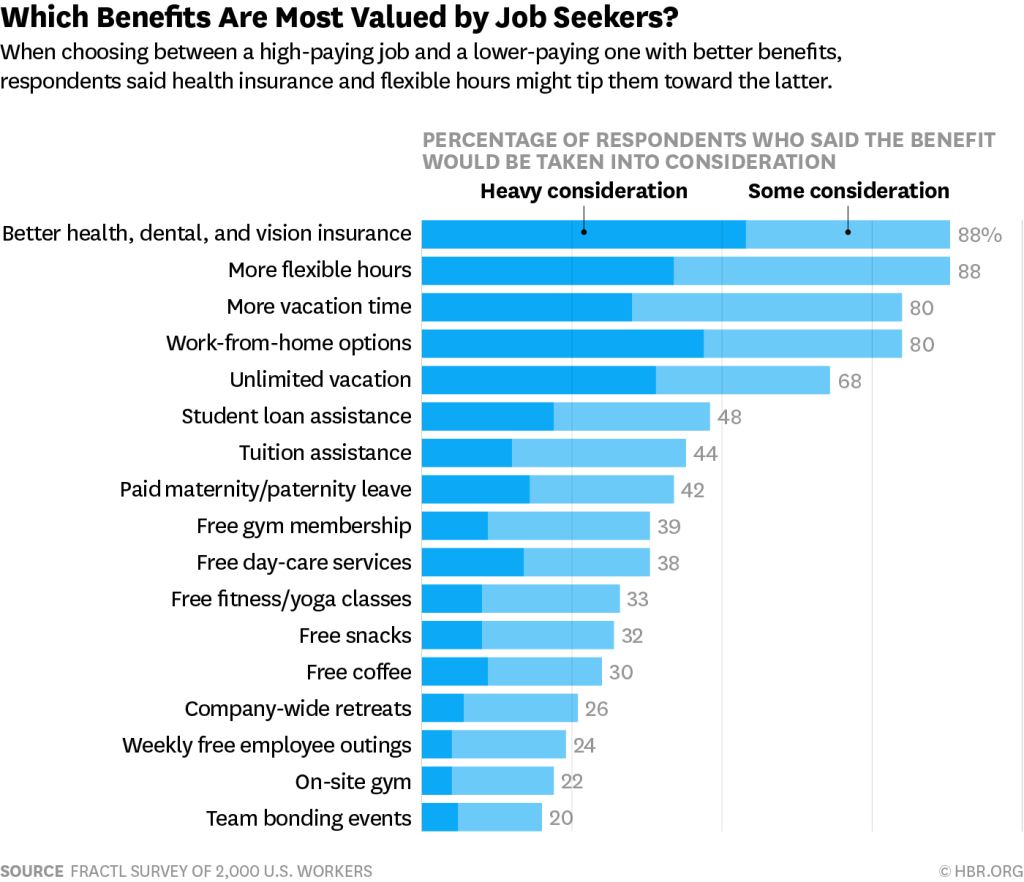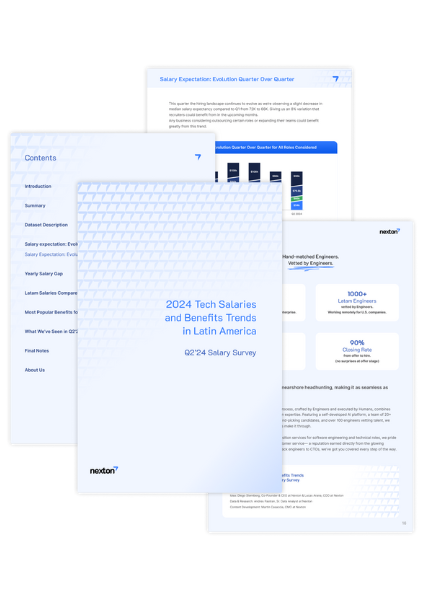A competitive salary is key to attracting top tech talent. But it’s far from the only way to add value to your job offer.
The best developers don’t just want to “make bank” with a high salary. More than anything, they want a great work atmosphere, flexible hours and challenging projects to rev up their careers.
Ultimately, non-monetary rewards can be crucial for successful retention. Here’s how your team can create a compelling non-monetary rewards strategy that benefits your employees and enriches their working experience in the long term.
Get in-depth market information about top tech benefits in our 2022 Tech Salaries & Benefits Trends Report!
Why You Need to Offer Non-Monetary Rewards
Money isn’t everything. That’s especially true at work, as studies show that compensation has little impact on employee job satisfaction.
Yet, it can be difficult to find and keep top tech talent these days for several reasons. In the current market, it’s especially important to consider non-monetary rewards that could shift the balance in your favor.
Some red flags that your recruitment strategy needs non-monetary rewards now include:
- Your tech turnover rate is high.
- You’re struggling to find the replacement talent you require in a fiercely competitive market.
- You can’t offer any higher salaries.
- Your tech team is never fully filled.
Take heart, for compensation isn’t the only driver for tech talent and you don’t need to watch your best developers leave. Instead, it’s time to build a non-monetary rewards strategy that boosts job satisfaction and retention for your developers.
How to Craft a Non-Monetary Rewards Strategy

A non-monetary rewards strategy is all about adding value for your employees. While it’s tempting to offer free snacks and call it a day, these minimal efforts are unlikely to inspire company loyalty. Here are some expert ways to build non-monetary rewards that actually matter to your tech talent.
1. Offer career rewards
The best way to add value for your tech talent is to create an actionable career advancement plan for each individual.
Having a path forward with clear milestones can help employees feel like they’re making progress, learning new skills and staying on track to obtain future promotions.
A great career advancement plan, for example, would include a learning budget for developers to attend conferences or take courses. It would also outline potential career paths that they may be interested in, as well as opportunities to job shadow or receive mentorship.
2. Meet pain points
 (Source: 2022 State of Remote Work Report)
(Source: 2022 State of Remote Work Report)
Another essential step is resolving employees’ pain points at work. Often these benefits can be tailored according to the problem that needs to be addressed.
Start by finding out what’s not going well in the workplace. For example, some common remote work issues include:
- Feeling undervalued → Offer public recognition of their work, as well as extra rewards such as more visible leadership and a performance bonus.
- Feeling burnout → Besides revisiting their workload and determining the root cause, you can set up an “unplug” program (where employees must sign out by 6:00 pm every day) and/or mental health days (such as pet therapy, massages, etc.).
- Feeling isolated → A whopping 24% of remote workers feel lonely. Address this by offering office parties, meet-ups, virtual coffee dates and more.
- Feeling stuck in their career → Some ideas include creating a mentorship program, giving time for their own projects and finding more challenging assignments.
3. Implement low-budget non-monetary rewards ASAP
When companies consider non-monetary perks, they often go straight to free coffee and ping-pong tables. However, there are plenty of low-budget non-monetary rewards that truly mean something to tech talent, such as:
- Flexible working policies, including remote and build-your-own schedule benefits.
- Quality of life programs, such as no-meeting Fridays, banning evening emails and other efforts to protect employees from overwork and burnout.
- A learning and development budget to attend conferences, take courses, etc.
- Regular company events, including innovation afternoons, brown bag lunches, an annual party, etc.
4. Invest in higher quality baseline perks

(Source: Harvard Business Review)
What employee wants a gift bag if they don’t have good health insurance? An excellent way to improve your non-monetary rewards strategy is to go back to the basics.
According to a study by Harvard Business Review, the most valued benefits have a high impact on the employee’s quality of life outside of work, including:
- More time off
- Better health insurance
- Tuition reimbursement
- Parental leave programs
Of course, these benefits come at a price, which is why companies may not offer the highest quality versions. If you’re looking to retain top talent, however, it may be an effective investment to upgrade these baseline benefits.
5. Get creative but meaningful with non-monetary rewards
Finally, there are some additional non-monetary rewards that are out-of-the-box. Keep in mind that while creative options may be interesting, they’re only useful if they’re meaningful to employees.
In other words, free lunch and company swag won’t cut it. Some more creative but high-impact options include:
- Stock and equity packages
- Crypto payments
- Wellness programs and stipends

Tips for Successfully Creating a Non-Monetary Rewards Strategy
Now that you have a good sense of what a non-monetary rewards strategy looks like, you’ll want to create your own. As you embark on this process, keep in mind these expert-backed tips.
1. Avoid a long-winded HR survey
While taking the pulse on your employees’ opinions is important, you should avoid creating a long-winded HR survey. There’s nothing quite like a 15-page survey to put off employees from answering honestly and thoroughly.
Cut to the chase by asking simply for 3-5 things that employees would want to change about the workplace. From here, you can get a sense of how to both resolve pain points and identify opportunities to add value.
2. Start with low-hanging fruit
Launching a new non-monetary rewards strategy doesn’t have to be a huge undertaking. Start with low-hanging fruit by implementing rewards that are low-budget and/or require minimal effort from your team.
For example, if you get feedback that your tech talent is feeling overwhelmed by late-night emails, nip this problem in the bud. Set up an “unplug” policy that employees can’t send emails after 6:00 pm (and ideally should log off from work as well).
3. Ensure perks and programs are followed through
Of course, there’s no use having an “unplug” policy when nobody follows it. A vital part of a successful non-monetary rewards strategy is ensuring implementation.
Get leadership on board to set the example of your reward programs and policies, and follow up at regular intervals to make sure they’re working as you intended. Doing so will also show your tech talent that you’re serious about protecting their time and benefits.
4. Weigh the price of benefits with talent acquisition costs
When tailoring your non-monetary rewards, you should also take the costs into account. Companies often believe they “don’t have the budget” for better benefits.
Yet, according to Gallup, the cost of replacing an employee may range from half to twice their annual salary. That means for a developer with a yearly salary of $100,000, your company may spend a minimum of $50,000 (and up to $200,000) on the replacement process. For example, you’ll have to foot the bill of talent acquisition costs, including having a partially filled team, recruiting the right developer, paying the new hire’s job package costs and more.
That’s a lot of money you’re leaving on the table when a developer leaves your company. Are you certain then that you can’t afford better benefits? Weigh the price of investing in benefits with these hefty talent acquisition costs. By doing the math, the way forward is clear.
5. Keep listening to your tech talent
What’s more, your non-monetary rewards strategy should never be static. To improve job satisfaction, company loyalty and retention in the long term, you should keep listening to your tech talent. Their pain points, career ideas and benefits wish list may evolve over time, so be sure you’re asking often and pivoting your strategy as needed.

Our Non-Monetary Rewards at Nexton
Non-monetary rewards are a necessary part of attracting and retaining top tech talent. As you design competitive job packages, don’t forget about identifying opportunities for high-impact, non-monetary rewards.
At Nexton, we strive to follow these best practices for non-monetary rewards. To give you an example, we offer our employees:
- A 4-day remote workweek
- A personalized career development plan
- An educational budget for English and/or Portuguese classes
- Mentorship opportunities
- A strong mission and multicultural teams
Learn more about our talent expertise at Nexton and how we help clients hire and retain elite developers from Latin America.
Check also:
- 2022 Tech Salaries & Benefits Trends Report
- The Complete Guide to Hire Technical Talent in LATAM
- From Good to Great: Rethinking Your Talent Sourcing Strategy
- Key Things to Keep in Mind to Hire Remote Engineers from Latin America
- How to Vet Tech Candidates to Optimize Recruitment
- I Hired the Wrong Candidate – Now What?
- Remote Work Culture as a Software Development Product
- How Remote Hiring in LATAM Can Help You Stay Afloat in This Downturn


